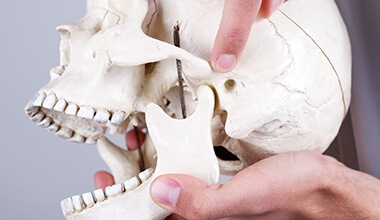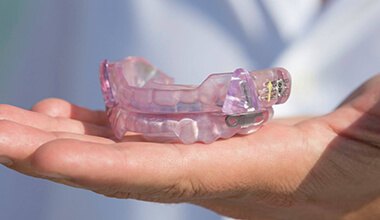TMJ Dysfunction Treatments
If you’ve experienced jaw pain and discomfort or limited jaw mobility, you may be suffering from temporomandibular joint dysfunction. Sometimes referred to as TMJ or TMD, this common oral health condition affects the small connective tissues that attach the jaw to the skull, and due to the variety of causes and symptoms, it can be difficult to treat effectively. Dr. Allan Milewski and his team have experience diagnosing and treating patients with TMJ dysfunction, and we can help you find relief from pain and renewed oral health. Contact our team to find out more or schedule an appointment.
Diagnosis
 The first step is to ensure we can make an accurate diagnosis in the earliest stages. We ask that you let us know right away if you experience any combination of the following TMJ dysfunction symptoms:
The first step is to ensure we can make an accurate diagnosis in the earliest stages. We ask that you let us know right away if you experience any combination of the following TMJ dysfunction symptoms:
- Jaw pain when opening and closing the mouth or an ache while the jaw is at rest
- Clicking or grinding sound when opening or closing the mouth
- Chronic headaches or earaches
- Radiating back, neck or shoulder pain
- Inability to fully extend the jaw or complete jaw immobility
Equilibration & Occlusal Adjustment
 The goal of TMD therapy is to properly align the jaw to prevent potential damage to the connective joints that can lead to painful or impeded jaw movement. This can often be done with some simple daily stretching exercises to keep the jaw properly aligned. In more advanced cases, we may need to provide more advanced occlusal (the way teeth fit together) adjustments using braces, aligners, retainers, or other orthodontic intervention as necessary.
The goal of TMD therapy is to properly align the jaw to prevent potential damage to the connective joints that can lead to painful or impeded jaw movement. This can often be done with some simple daily stretching exercises to keep the jaw properly aligned. In more advanced cases, we may need to provide more advanced occlusal (the way teeth fit together) adjustments using braces, aligners, retainers, or other orthodontic intervention as necessary.
Occlusal Splints
 During sleep, patients are unable to consciously control their jaw movements. This is the time their TMJ are at the greatest risk for damage or strain. One of the simplest forms of TMJ therapy is an occlusal splint. Worn during sleep, these comfortable mouthpieces are custom crafted to fit snuggly against the teeth. While wearing your appliance, you can speak, breathe easily, and even drink water. The oral appliance is crafted to position the jaw into the ideal resting location in order to relieve excess strain and prevent unnecessary movement during the night. After a few days wearing their oral appliance, patients typically notice significantly reduced pain and improved jaw function. After weeks or months of nightly use, patients should notice dramatic improvement in overall function and comfort. Continued use of the occlusal splint may even permanently reposition patients’ jaws in this more comfortable alignment even while they aren’t being worn.
During sleep, patients are unable to consciously control their jaw movements. This is the time their TMJ are at the greatest risk for damage or strain. One of the simplest forms of TMJ therapy is an occlusal splint. Worn during sleep, these comfortable mouthpieces are custom crafted to fit snuggly against the teeth. While wearing your appliance, you can speak, breathe easily, and even drink water. The oral appliance is crafted to position the jaw into the ideal resting location in order to relieve excess strain and prevent unnecessary movement during the night. After a few days wearing their oral appliance, patients typically notice significantly reduced pain and improved jaw function. After weeks or months of nightly use, patients should notice dramatic improvement in overall function and comfort. Continued use of the occlusal splint may even permanently reposition patients’ jaws in this more comfortable alignment even while they aren’t being worn.

